Pavlo Skoropadskyi
Pavlo Petrovych Skoropadskyi (Ukrainian: Павло Петрович Скоропадський, romanized: Pavlo Petrovyč Skoropadśkyj; Russian: Павел Петрович Скоропадский, romanized: Pavel Petrovič Skoropadskij; German: Paul Petrowitsch Skoropadskyj; 15 May [O.S. 3 May] 1873 – 26 April 1945) was a Ukrainian[1] aristocrat, military and state leader,[2] decorated Imperial Russian Army and Ukrainian Army general of Cossack heritage. Skoropadsky became a conservative leader in Ukraine following the Russian Revolution of 1917, a founder of a hetman dynasty and Hetman of Ukraine.
Pavlo Skoropadskyi Павло Петрович Скоропадський | |
|---|---|
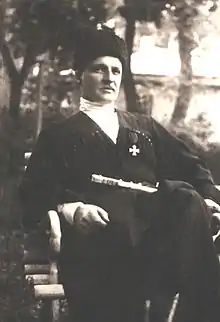 | |
| Hetman of Ukraine | |
| In office 29 April 1918 – 14 December 1918 | |
| Preceded by | Mykhailo Hrushevsky (as President of Central Rada) |
| Succeeded by | Volodymyr Vynnychenko (Chairman of the Directory) |
| Personal details | |
| Born | 15 May 1873 Wiesbaden, Germany |
| Died | 26 April 1945 (aged 71) Bavaria, Germany |
| Political party | Ukrainian People's Hromada |
| Spouse(s) | Oleksandra Skoropadska |
| Children | Danylo Skoropadskyi Maria Yelyzaveta Olena Skoropadska |
| Awards | Order of St. George (1914) Order of St. Vladimir Order of St. Anna Order of St. Stanislaus |
| Military service | |
| Allegiance | |
| Years of service | 1891–1918 |
| Rank | Lieutenant General |
| Battles/wars | Russo-Japanese War First World War Invasion of Prussia Ukrainian War of Independence |
Origin
Pavlo Skoropadskyi was born into the Skoropadsky family of Ukrainian military leaders and statesmen, that distinguished themselves since the 17th century when Fedir Skoropadsky participated in the Battle of Zhovti Vody.
Skoropadskyi's father Petro Ivanovych Skoropadsky (1834–1885) was a Cavalry Guard Colonel and a veteran of the Caucasian War (Subjugation of Circassia, 1863). Afterwards he served as a speaker (marshal) for the Starodub County Council (zemstvo) (1869–1885) until his death.
Skoropadskyi's aunt Countess Yelyzaveta Myloradovych (née Skoropadska) (1832–1890) was a Ukrainian public activist. She was one of the main sponsors for foundation first Ukrainian scientific institution Shevchenko Scientific Society in Lviv. Her husband was Count Lev Myloradovych whose mother was from the Kochubey family.
His grandfather Ivan (1804–1887) also served as a speaker for the Pryluky County (1844–1847) and Poltava Governorate (1847–1852) councils. He also was known for building the Trostyanets Arboretum (today in Chernihiv oblast). Skoropadskyi's father Petro Ivanovych was also a descendant of the Tarnovsky family, while Skoropadskyi's mother was a descendant of Miklashewsky and Olsufiev families.
Skoropadskyi grew up at his father's estate in Trostianets, Pryluky County, Poltava Governorate. He attended a gymnasium in Starodub and later graduated from the Page Corps cadet school in Saint Petersburg.
Military career
First assignments and Russo-Japan War
In 1893 Skoropadsky graduated from the Page Corps and was assigned as a cornet (meaning the 2LT in cavalry) to the Chevalier Guard regiment where he was put in charge of a squadron. After two years he was assigned a duty of the Regimental adjutant in the same regiment. In December 1897 he was promoted to Poruchik (1LT). In 1897 Skoropadsky also married Aleksandra Petrovna Durnovo, a daughter of Pyotr Pavlovich Durnovo, the General Governor of Moscow (see Durnovo).
Skoropadsky's first major assignment was a sotnia (company) commander in the 2nd Chita Cossack Regiment of the Trans-Baikal Cossack Host in Chita during the Russo-Japanese War. Later he became an adjutant to the commander of the Russian forces on the Far East General Nikolay Linevich. During the war Skoropadsky was awarded the George's Weapon and several orders. In December 1905 Tsar Nikolai II made him a Fliegel-Adjutant in a rank of Colonel. On September 4, 1910 Colonel Skoropadsky was commissioned as the commander of the 20th Finnish Dragoon Regiment still continuing to be a Fliegel-Adjutant of the H. I. M. Retinue. On April 15, 1911 he was reassigned to the Leib-Guard Cavalry Regiment. Leib-Guards were the elite Russian military forces assigned for a personal protection of the emperor. On December 6, 1912 Skoropadsky was promoted to the Major General of the H. I. M. Retinue.
World War I
At the start of World War I, Skoropadsky was put in charge of the reorganized 1st Brigade of the 1st Cavalry Guard Division (General Nikolai Kaznakov) as part of the 1st Army commanded by General Paul von Rennenkampf. Skoropadsky already worked for von Rennenkampf during the Russo-Japanese War when the last was commanding Trans-Baikal Cossack Host. On August 6, 1914, his regiment distinguished itself in battles near Kraupishken as part of the Russian invasion of East Prussia. Later he was appointed as a commander of the United Cavalry Guard Division which distinguished near Kaushen. General Skoropadsky also commanded the 5th Cavalry Division. On April 2, 1916, he was promoted to Lieutenant General and was commissioned the 1st Cavalry Guard Division. From January 22 to July 2, 1917, he is in charge of the 34th Army Corps. In July 1917 the decommissioned 34th Army Corps was transformed into the 1st Ukrainian Corps. In October 1917 at the first Congress of the Free Cossacks he was awarded a title of the honorary Otaman. From October to November 1917 his 60,000-man Army Corps successfully defended the railway corridor stretching through Podolie to Polissya, Vapniarka – Zhmerynka – Koziatyn – Shepetivka and defended against the attacks from the Romanian front particularly the 2nd Guard Corps that was headed by Yevgenia Bosch.
Political life
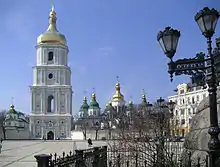
On 29 April 1918, a coup d'etat toppled the Ukrainian People's Republic and Skoropadsky became Hetman of Ukraine. The same day he was chrismated by bishop Nykodym in Saint Sophia Cathedral as the Hetman of Ukraine.
The coup d'état had been sanctioned by the Imperial German Army, which in the spring of 1918 had occupied Kyiv and other parts of Ukraine. The Ukrainian Republic was intent upon repelling an invasion by the Bolshevik Red Army. In return, the Republican government pledged food stocks, which were to be expropriated from the peasants. The German General Staff was dissatisfied with the inefficiency and incompetence of the Republican government, which repeatedly failed to deliver the supplies on time.
Skoropadsky was accused by other Ukrainian nationalists of being a German collaborator supported by wealthy landowners. He was also considered too pro-Russian and dictatorial. Among other things, Skoropadsky formed a cabinet of mainly Russian speakers, Tsarists, and Slavophiles. Simultaneously, he committed Ukraine to federation with a restored Russian Empire.
Despite these criticisms, by contrast with the earlier socialist Rada, his government was given credit for having created an effective administrative organization, established diplomatic ties with many countries, concluded a peace treaty with Soviet Russia, and built many schools and universities, including the National Academy of Sciences of Ukraine.
In November 1918 Skoropadsky was removed from power in an uprising led by the social democrat Symon Petliura and the withdrawal of German forces from Kyiv. The uprising nominally restored the Ukrainian People's Republic, but power was vested in a Directoria, a provisional government of five directors chaired by Volodymyr Vynnychenko. Skoropadsky abdicated on December 14, 1918 and fled to Berlin.
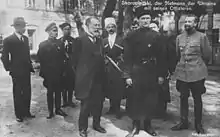
While living in Weimar Germany, Skoropadsky maintained close personal friendships with senior government and army officials originating as far back as his military-college days. In later years, however, he consistently refused offers to collaborate with the Nazis. During World War II, Skoropadsky fled from advancing Soviet forces with the retreating German army. He died at Metten Abbey in Germany after being wounded by an Allied bombing near Regensburg, and was buried in Oberstdorf.
His movement continued into the early 1980s, influencing a Ukrainian monarchist program based on the Cossack State model. It ended gradually with the aging of eastern-Ukrainian émigré communities. Skoropadsky's daughter, Olena Skoropadska-Ott (died 2014), resided in Switzerland, visited Ukraine several times, and had been honored for her historical writings.
Honors
 Order of St. Anne 4th degree, 1904
Order of St. Anne 4th degree, 1904 Order of St. Anne 3rd degree with swords and bow, 1904
Order of St. Anne 3rd degree with swords and bow, 1904 Order of St. Stanislaus 2nd class with swords, 1905
Order of St. Stanislaus 2nd class with swords, 1905.png.webp) Order of St Vladimir, 4th degree with swords and bow, 1905
Order of St Vladimir, 4th degree with swords and bow, 1905- Gold Sword for Bravery, 1905
 Order of St. Anne 2nd degree with swords, 1906
Order of St. Anne 2nd degree with swords, 1906.png.webp) Order of St Vladimir, 3rd degree, 1900
Order of St Vladimir, 3rd degree, 1900 Order of St. George, 4th class,
Order of St. George, 4th class, Order of the Red Eagle, 1918 (Prussia)
Order of the Red Eagle, 1918 (Prussia)
Family
Pavlo Skoropadskyi | |
|---|---|
| Coat of arms | 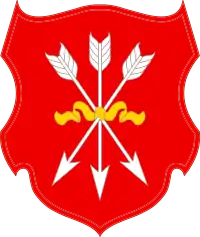 |
| Noble family | Skoropadsky family |
Pavlo Skoropadskyi | |
|---|---|
| Coat of arms |  |
| Noble family | Durnovo family |
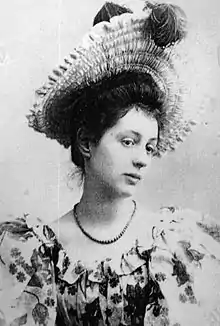
On January 11, 1898, Skoropadsky married the Russian noblewoman Aleksandra Durnovo, a daughter of the Russian soldier and statesman Pyotr Durnovo (of a notable family of Russian statesmen and landowners) and Maria Vasiliyevna (of Ukrainian Cossack Kochubey noble family).
The couple had six children:
- Maria (1898-12 February 1959), who married Adam de Montrésor.
- Yelyzaveta (1899-16 February 1976),[3] who married Mr. Kuzhym, a painter, sculptor, leader of Hetman Movement (1959-?).
- Petro (1900-1956), who suffered from epilepsy.
- Danylo (1906-23 February 1957).
- Pavlo (1915-1918), who died from disease.
- Olena (5 July 1919 – 4 August 2014),[4] who married Gerd Ginder (died on April 10, 1945) on August 31, 1943, and married Ludwig Ott on March 20, 1948; her two children are:
Ancestry
| Ancestors of Pavlo Skoropadskyi | |||||||||||||||||||||||||||||||||||||||||||||||||||||||||||||||||||||||||||||||||||||||||||||||||||||||||||||||||||||||||||||||||||||||||||||||||||||||||||||||||||||||||||||||||||||||||||||||||||||||||||||||||||||||||||||||||||||||||||||||||||||||||||||||||||||||||||||||||||||||||||||||||||||||||||||||||||||||||||||||||||||||||||||||||||||||||||||||||||||||||||||||||||||||||||||||||||||||||||||||||||||||||||||||||||||||||||||||||||||||||||||||||||||||||||||||||||||||||||||||||||||||||||||||||||||||||||||||||||||||||||||
|---|---|---|---|---|---|---|---|---|---|---|---|---|---|---|---|---|---|---|---|---|---|---|---|---|---|---|---|---|---|---|---|---|---|---|---|---|---|---|---|---|---|---|---|---|---|---|---|---|---|---|---|---|---|---|---|---|---|---|---|---|---|---|---|---|---|---|---|---|---|---|---|---|---|---|---|---|---|---|---|---|---|---|---|---|---|---|---|---|---|---|---|---|---|---|---|---|---|---|---|---|---|---|---|---|---|---|---|---|---|---|---|---|---|---|---|---|---|---|---|---|---|---|---|---|---|---|---|---|---|---|---|---|---|---|---|---|---|---|---|---|---|---|---|---|---|---|---|---|---|---|---|---|---|---|---|---|---|---|---|---|---|---|---|---|---|---|---|---|---|---|---|---|---|---|---|---|---|---|---|---|---|---|---|---|---|---|---|---|---|---|---|---|---|---|---|---|---|---|---|---|---|---|---|---|---|---|---|---|---|---|---|---|---|---|---|---|---|---|---|---|---|---|---|---|---|---|---|---|---|---|---|---|---|---|---|---|---|---|---|---|---|---|---|---|---|---|---|---|---|---|---|---|---|---|---|---|---|---|---|---|---|---|---|---|---|---|---|---|---|---|---|---|---|---|---|---|---|---|---|---|---|---|---|---|---|---|---|---|---|---|---|---|---|---|---|---|---|---|---|---|---|---|---|---|---|---|---|---|---|---|---|---|---|---|---|---|---|---|---|---|---|---|---|---|---|---|---|---|---|---|---|---|---|---|---|---|---|---|---|---|---|---|---|---|---|---|---|---|---|---|---|---|---|---|---|---|---|---|---|---|---|---|---|---|---|---|---|---|---|---|---|---|---|---|---|---|---|---|---|---|---|---|---|---|---|---|---|---|---|---|---|---|---|---|---|---|---|---|---|---|---|---|---|---|---|---|---|---|---|---|---|---|---|---|---|---|---|---|---|---|---|---|---|---|---|---|---|---|---|---|---|---|---|---|---|---|---|---|---|---|---|---|---|---|---|---|---|---|---|---|---|---|---|---|---|---|---|---|---|---|---|---|---|---|---|---|---|---|---|---|---|---|---|---|---|---|---|---|---|---|---|---|---|---|---|---|---|---|---|---|---|---|---|---|---|---|---|---|---|---|---|---|---|---|---|---|---|---|---|---|---|---|---|---|---|---|---|---|---|---|---|---|---|---|---|
| |||||||||||||||||||||||||||||||||||||||||||||||||||||||||||||||||||||||||||||||||||||||||||||||||||||||||||||||||||||||||||||||||||||||||||||||||||||||||||||||||||||||||||||||||||||||||||||||||||||||||||||||||||||||||||||||||||||||||||||||||||||||||||||||||||||||||||||||||||||||||||||||||||||||||||||||||||||||||||||||||||||||||||||||||||||||||||||||||||||||||||||||||||||||||||||||||||||||||||||||||||||||||||||||||||||||||||||||||||||||||||||||||||||||||||||||||||||||||||||||||||||||||||||||||||||||||||||||||||||||||||||
See also
Pavlo Skoropadskyi Family of Skoropadsky Born: 3 May 1873 Died: 26 April 1945 | ||
| Regnal titles | ||
|---|---|---|
| Preceded by title created |
Hetman of Ukraine 1918 |
Succeeded by none |
| Titles in pretence | ||
| Preceded by none |
Hetman of Ukraine 1918–1945 |
Succeeded by Oleksandra Skoropadska |
References
- Book by Omeljan Pritsak Lviv, 1938 (in Ukrainian) Archived 2013-12-11 at the Wayback Machine
- "СКОРОПАДСКИЙ, ПАВЕЛ ПЕТРОВИЧ - Энциклопедия Кругосвет". www.krugosvet.ru.
- "The Ukrainian Week". ukrainianweek.com.
- "7 ДНІВ-УКРАЇНА » У Швейцарії померла донька останнього гетьмана України Павла Скоропадського". 7days-ua.com.
- "Olena Ott-Skoropadsky: Memories of my childhood (21 Jan 2012)".
- "2009 року Олена Отт-Скоропадська відзначить своє 90-річчя". 14 April 2009.
- "Gedenkseite von Olena Ott-Skoropadsky - trauer.nzz.ch". trauer.nzz.ch.
- V. I. Lenin "Everybody On Food And Transport Work!" Endnote: "In November–December 1918 the Ukrainian workers and peasants rose up against the German invaders and their stooge, Hetman Skeropadsky. On December 14 Skoropadsky fled from Kiev."
External links
![]() Media related to Pavlo Skoropadsky at Wikimedia Commons
Media related to Pavlo Skoropadsky at Wikimedia Commons
- Biography (in Ukrainian)
- Secret Police of Hetman Skoropadsky, The Papers of the Provisional Government of Ukraine, 1918 (Russian: Тайная полиция гетмана Скоропадского. Документы осведомительного отдела при киевском градоначальнике, Translit. Russian: Tainaia politsiia getmana Skoropadskogo. Dokumenty osvedomitelnogo otdela pri kievskom gradonachalnike) from East View Information Services
- The Secret Police of Hetman Skoropadsky Research collection in microform.
- Biography from Encyclopedia of Ukraine, vol. 4 (1993)